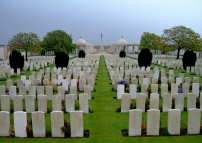| First Name: | Charles William | Last Name: | MAY | |
|---|---|---|---|---|
| Date of Death: | 25/09/1915 | Lived/Born In: | Earlsfield | |
| Rank: | Private | Unit: | Royal West Surrey (Queens)2 | |
| Memorial Site: | Loos Memorial, France | |||
Current Information:Born-Wandsworth
The Battle of Loos, fought by the British Army from 25th September, 1915 through to 13th October, was conducted along a six-and-a-half-mile front running north from the mining village of Loos on the outskirts of Lens in Northern France. It was the largest offensive carried out by the British so far. The opening day involved an attack by six divisions, with others entering the fray as it progressed and it was part of a much wider offensive with the French launching their own attacks in Champagne and at Vimy. It was the first time that the British used gas during the war, despite their condemnation of the Germans for doing the same in April 1915. There were some encouraging results on the first day but no major breakthrough was achieved and in the successive days of the battle it became bogged down in brutal trench warfare. By mid-October the battle had petered out with the British having suffered over 60,000 casualties during its course. On 25th September 1915 7th Division attacked along a 1400 yard front between the Vermelles-Hulluch road and the Hohenzollern Redoubt but not including that stronghold. Along this stretch of the line the German defences were strong and had not been damaged much by the bombardment. There were a number of strongpoints notably the Popes Nose Redoubt and The Quarries from which enfilade fire could be directed on the attackers. The villages just behind the German line, Hulluch, Cité St. Elie, Haisnes and La Bassée, were all strongly defended. At 5.50am on 25th September, 1915, a heavy British bombardment commenced and the gas cloud of chlorine was released. The gas on this stretch of the front had mixed results. The wind was not favourable every where and in some places it was not used. At 6.30am 22 Brigade attacked with 1st South Staffordshire and 2nd Warwickshire. Their advance was hindered by the gas and the smoke screen laid down did not cover the last 30 yards to the German line. To add to their woes the German wire, hidden by long grass, was thick and uncut. In these circumstances it was not surprising that both battalions suffered heavy losses before they reached the first German line. But they pushed on and supported by 1st Royal Welsh Fusiliers, who also incurred many casualties, they forced their way in. By 7.30am the German support line 100 yards behind, was taken as well. A stronghold, Slit Redoubt, held on for a while but eventually surrendered. At 8.30am, 2nd Royal West Surrey (Queens) from Brigade reserve moved up and attacked the Quarries which they captured an hour later. Small parties of 2nd Royal West Surrey (Queens) and 1st South Staffordshire pushed on to Cité St. Elie but heavy fire and uncut wire forced them all back to the Quarries where the position was consolidated. By evening it had been roughly wired by Royal Engineers. |
||||
| « Back to Search Results | ||||
| If you think any of the information shown here is incorrect, Click Here to submit your amends and comments | ||||




